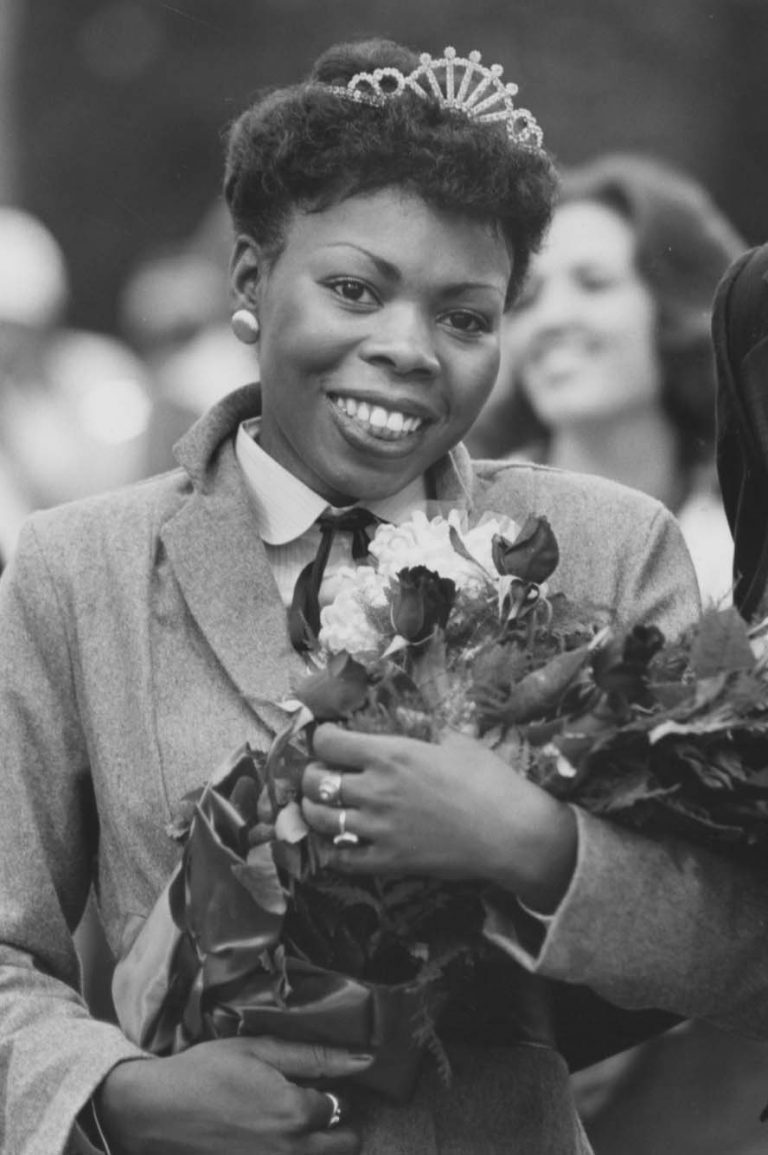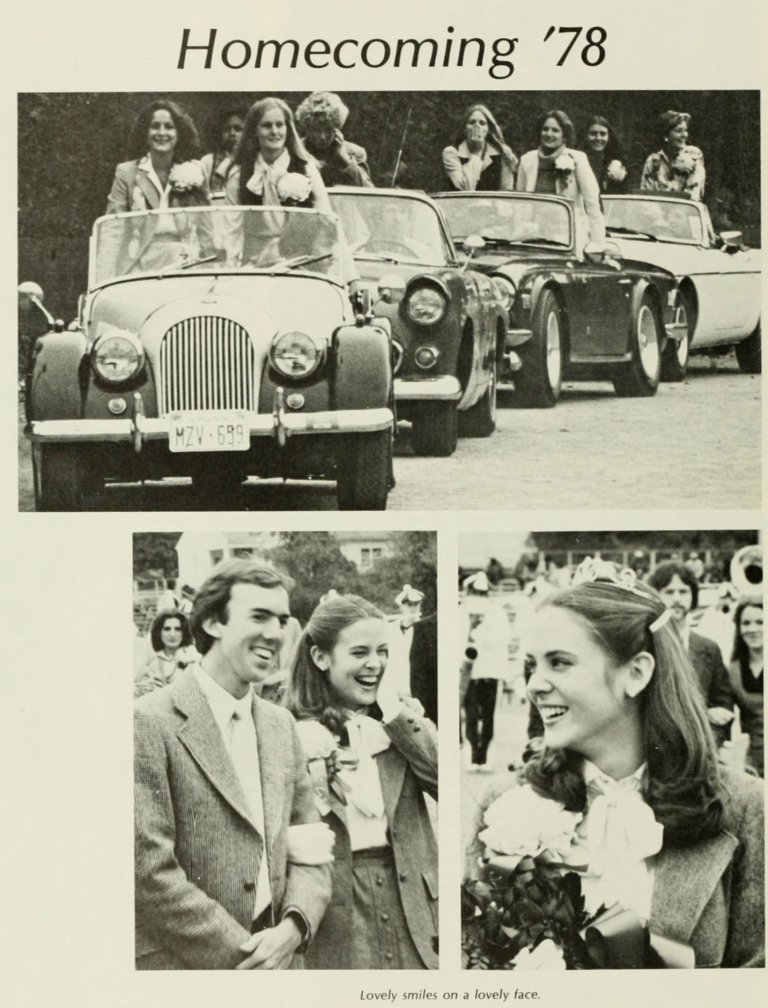- Home
- Teaching about Anti-Black Racism from Elon’s History
- Teachable Moments
- Mary Carroll and BELONging
Mary Carroll and BELONging
About Mary Carroll
Mary Carroll Robertson (nee Mary Carroll) arrived at Elon in fall 1977 and won election as Homecoming Queen in 1979. The practice of naming a Homecoming Court continues, but it was in full swing in the 1970s, and Carroll’s election was a high honor. Some white students, however, booed Carroll when she was crowned. Adding to the injury, white students editing the yearbook did not include the customary Homecoming spread in the 1980 edition. The school’s information officer explained that the students working on the yearbook had simply missed a deadline. Two Black students, James Strickland and Alonzo Craig, nonetheless burned their yearbooks in protest. Scores of other Black students followed their example. Not until 2019, did any representatives of Elon attempt to make amends.
Photo Gallery
Timeline
- 1963Glenda PhillipsGlenda Phillips becomes the first full-time Black student at Elon.
- 1964Civil Rights ActThe Civil Rights Act prohibits discrimination in education.
- 1968Black Studies ProgramBlack students join a coalition at San Francisco State University and successfully fight for a Black Studies Program (part of a new College of Ethnic Studies).
- 1969Eugene PerryEugene Perry becomes the first Black student to graduate from Elon.
- 1979Mary CarrollMary Carroll elected first Black Homecoming Queen in Elon History.
- 1980Phi Psi CliThe Phi Psi Cli (Elon Yearbook) does not include its traditional Homecoming spread. Students burn yearbooks, in a protest so substantial “Jet” magazine acknowledges it.
- 1980NAIA National ChampionsThe Elon football team wins back-to-back NAIA national championships in 1980 and 1981.
- 1983Vanessa WilliamsVanessa Williams is crowned the first Black Miss America (crowned in September for 1984 “reign”).
- 1992Eva ClaytonEva Clayton becomes first Black person elected to represent NC in the US House of Representatives since the Wilmington Race Massacre and white supremacy campaign of 1898, and the first-ever Black woman.
- 1994African and African American StudiesEstablishment of new minor at Elon: African and African American Studies
Sources
Primary Sources
- Phi Psi Cli (Elon Yearbook), Homecoming Spread (1978, 1980) – The 1979 student yearbook contained coverage of the 1978 Homecoming Court. There were no Homecoming photos in 1980, but the spread returned in 1981 (covering the 1980 Court). Notably, this Court included runner-up Nish Bynum and escort Ramon Jackson, both African American.
- “Black Queen Left Out: Students Burn Yearbooks,” Jet Magazine (June 19, 1980): 52. – Brief discussion of the yearbook burning, including the explanation by spokesman Tim McDowell that students simply missed a deadline.
- Joy Hamilton and Robin Adams, “The Unspoken Prejudice,” The Pendulum (March 5, 1981) – Hamilton and Adams mention Carroll as an indicator of Black success at Elon, even as they document and critique anti-Black racism among the predominantly white student body.
- Mary Carroll Robertson, Interviews by L’Tanya Richmond in “Elon’s Black History: A Story to Be Told” (Master’s Thesis, Duke University, 2004) – In this two-part interview, Carroll-Robertson recounts her day-to-day experiences as an Elon student.
- Krista Naposki, “Former student shares his experiences from the 70s,” The Pendulum (March 3, 2005) – Bryant Colson, first African American President of SGA, returned to campus for an interview and commented on Carroll’s composure when she did not appear in the yearbook.
- Robin Adams Cheeley, “Yes Elon, You Can Fix This,” Greensboro News and Record (November 19, 2019) – Cheely, a coauthor of the 1981 Pendulum letter above, wrote to describe and raise concerns about Mary Carroll Robertson’s return to campus in 2019 and her recognition at Homecoming.
Secondary Sources
- Joy Williamson, “In Defense of Themselves: The Black Student Struggle for Success and Recognition at Predominantly White Colleges and Universities,” Journal of Negro Education, 68, n. 1 (Winter 1999): 92-105. – Williamson offers a useful overview of the first two decades of integration of higher education, identifies institutional supports Black students sought “in defense of themselves,” and discusses the meaning of student success.
- Margaret M. Zamudio and Francisco Rios, “From Traditional to Liberal Racism: Living Racism in the Everyday,” Sociological Perspectives, 49, n. 4 (Winter 2006): 483-501. – Zamudio and Rios use student journals to document myriad encounters with racism (specifically the “liberal racism” that evolved on college campuses from the 1970s) and conclude “that the contemporary ‘colorblind’ discourse of the liberal era suggests an ongoing race project centered on the maintenance of white privilege.”
- Daniel Solorzano, Miguel Ceja,and Tara Yosso, “Critical Race Theory, Racial Microaggressions, and Campus Racial Climate: The Experiences of African American College Students,” Journal of Negro Education, 69, n. 1/2 (Winter-Spring 2000): 60-73. – This is an excellent discussion of microaggressions and the cumulative effect on the well-being of people of color and on campus climate more generally.
- Buffie Longmire-Avital and Ruthie Robinson, “Young, Depressed, and Black: A Comparative Exploration of Depressive Symptomatology Among Black and White Collegiate Women,” Journal of College Student Psychotherapy, 32, n. 1 (2018): 53-72. – Longmire-Avital and Robinson show the effect of “racial battle fatigue” on Black collegiate women and suggest reasons why Black women at predominantly white institutions might be less likely to seek help for depression.
In-Class Work
Any of the primary sources individually merits a close reading. Taken together, they offer good possibilities for in-class work. Examples include:

